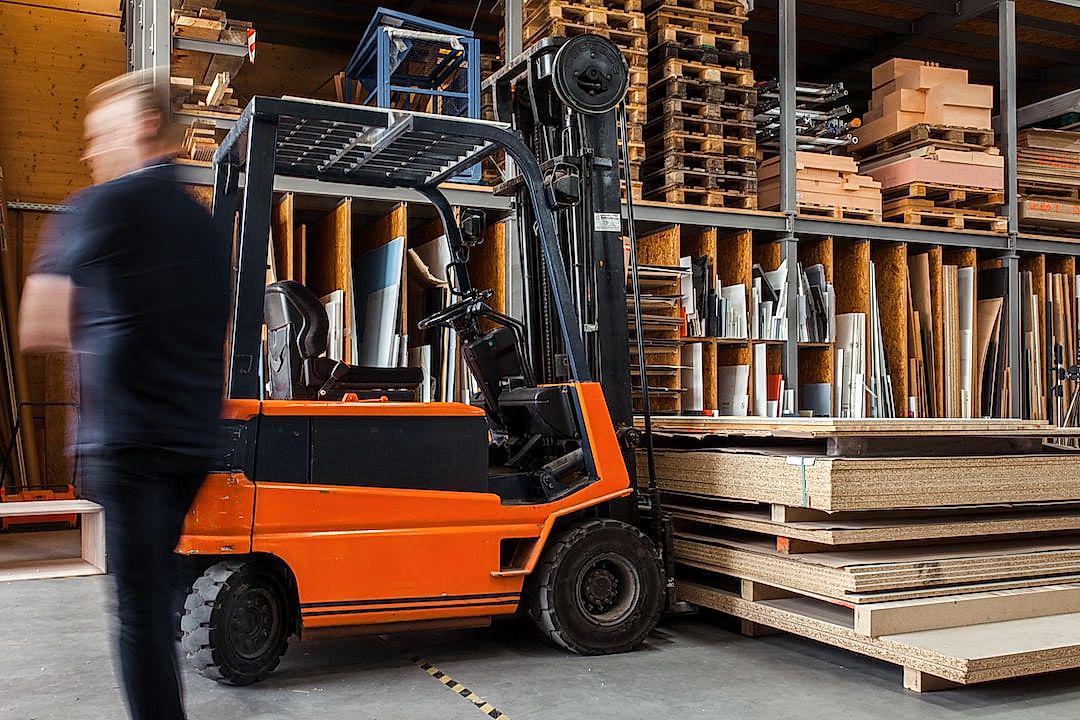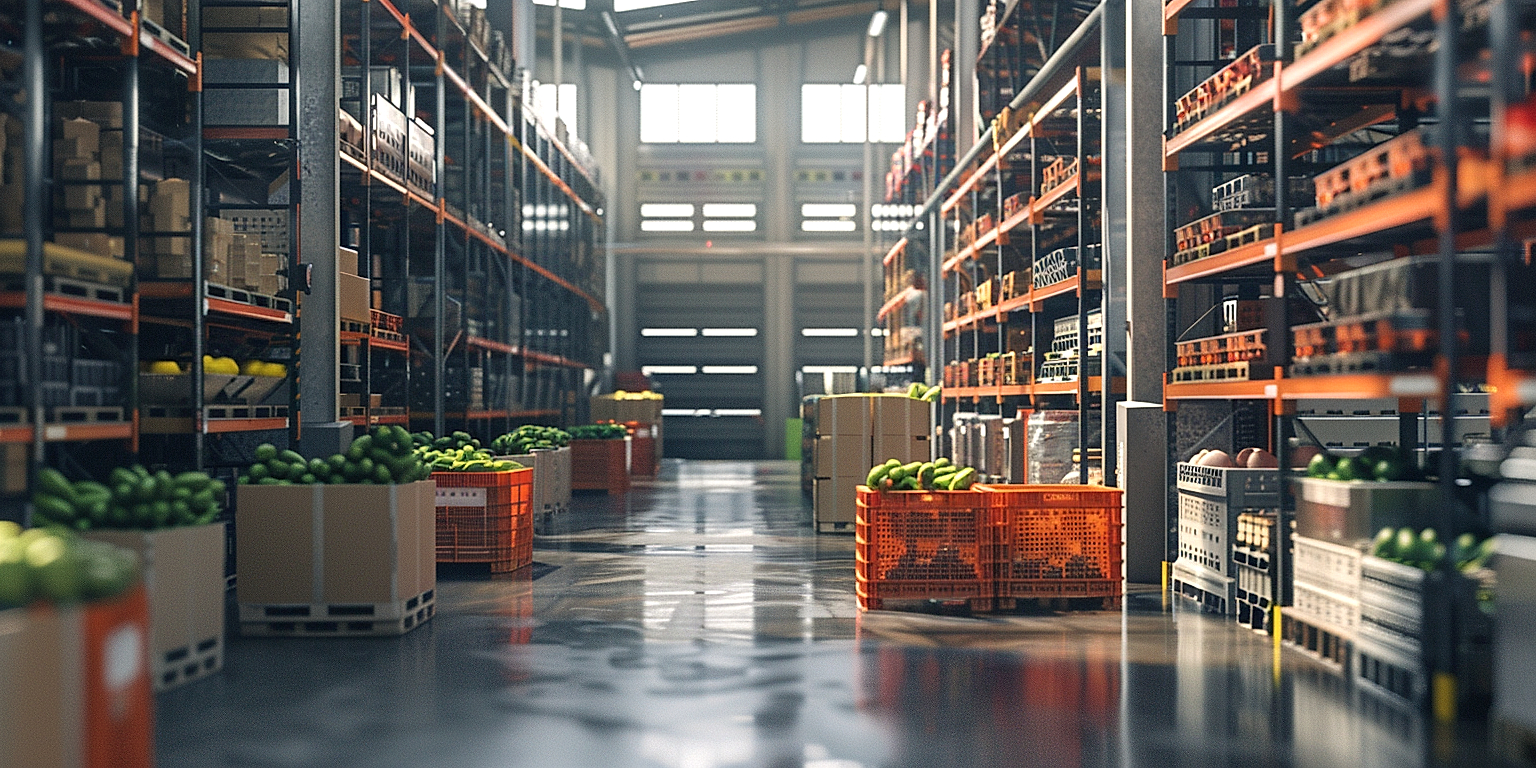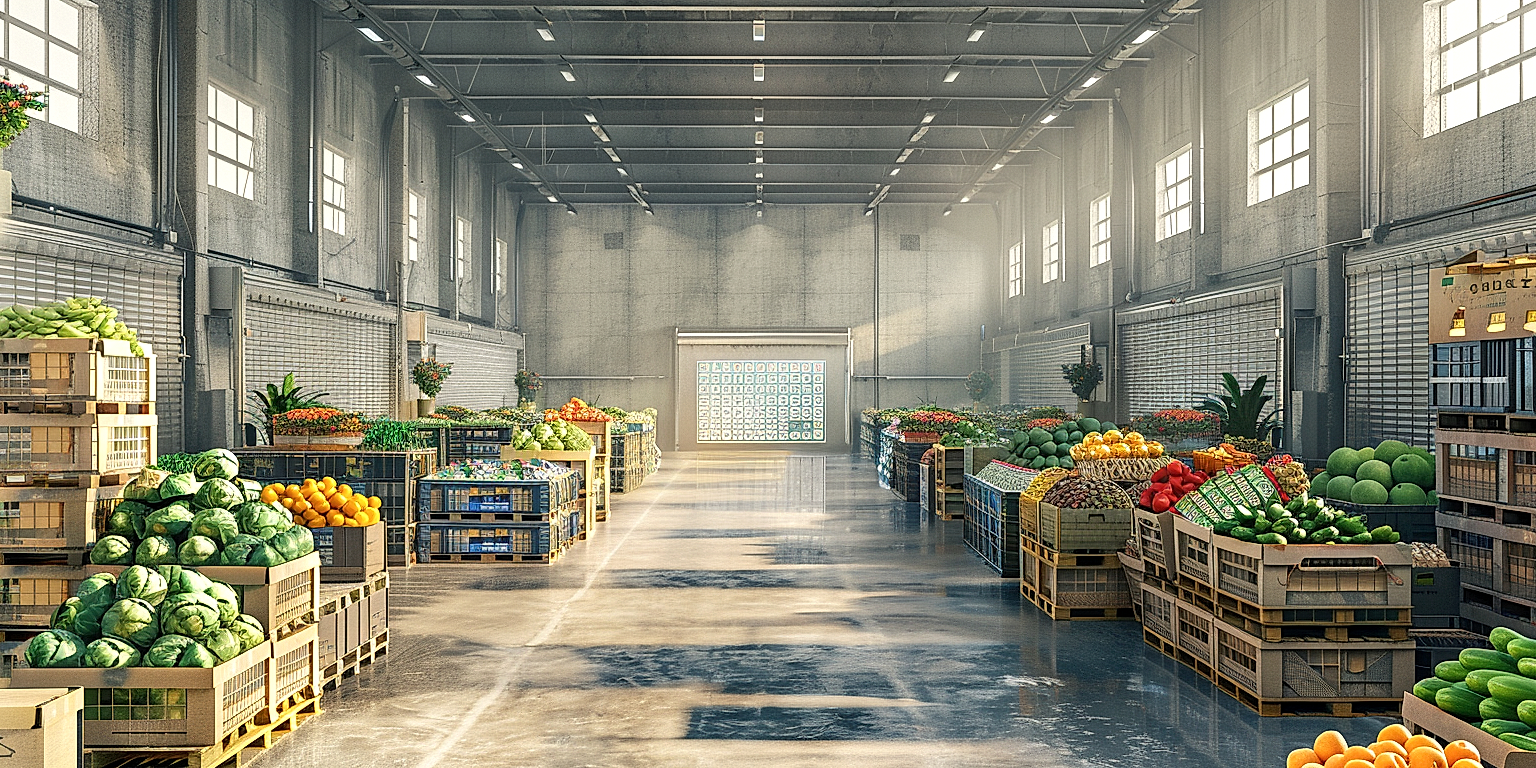Efficiency and sustainability form the cornerstone of modern industry operations.
The environmental footprint each business leaves can directly affect their reputation and bottom line.
No sector embodies this philosophy more than produce distribution warehouses where waste management plays a pivotal role.
However, many continue to grapple with the challenge of reducing waste without hampering operational efficiency.
This blog post will address cogent strategies for tackling this issue in a practical and affordable manner.
The aim is to aid businesses in implementing waste reduction methods without sacrificing their productivity or profits.
Contents
- Waste Reduction Ideas For Produce Distribution Warehouses
- 1. Implement edible packaging for produce.
- 2. Recycle or Compost all Organic Waste
- 3. Use efficient inventory software to reduce spoilage.
- 4. Encourage eco-friendly packaging from suppliers.
- 5. Organize regular maintenance of machinery
- 6. Minimize transportation through optimized routes
- 7. Use returnable or reusable transport packaging.
- 8. Reduce the use of plastic packing materials.
- 9. Install solar panels for energy efficiency.
- 10. Promote Bulk Purchasing to Decrease Packaging
- The Bottom Line
Waste Reduction Ideas For Produce Distribution Warehouses
1. Implement edible packaging for produce.
In the quest for sustainable practices, the recent invention of edible packaging for produce represents a significant game-changer.
The adoption of this innovative technology could help to drastically reduce waste generation in your produce distribution warehouse.
What exactly is edible packaging? Well, basically, it’s a form of packaging created from various edible materials such as seaweed, milk proteins, and plant starches.
They are designed to not only keep the produce fresh but also be consumable together with the produce or compostable if not consumed.
Imagine having an apple with a covering you can eat – less plastic waste, more nutrition!
This not only eliminates the need for conventional plastic packaging that ends up in the landfill but also provides an innovative way to reduce food waste.
Further, edible packaging tends to be biodegradable and compostable, further enhancing its environmental friendliness.
By implementing edible packaging, your produce distribution warehouse would make significant strides towards achieving sustainability goals.
Now, turning to the drawbacks, some concerns might arise regarding the potential influence on taste or the shelf life of the produce.
However, advancements in food engineering technologies have ensured these edible containers and coatings are generally tasteless and enhance the shelf life of the produce they protect.
Additionally, one might argue about the cost implications of such packaging, considering it’s a relatively new technology.
While it is true that the initial costs might be higher than traditional plastic packaging, it’s important to consider the long-term benefits.
Waste management expenses, environmental levy fees, and even PR benefits of being a green company might provide a significant return on investment.
In wrapping up, edible packaging is an innovative, eco-friendly packaging solution that every produce distribution warehouse should consider.
Given the alarming statistics of plastic waste worldwide, the adaption of these materials could significantly reduce your warehouse’s contribution to global plastic pollution.
We highly encourage produce distribution warehouses to consider the implementation of edible packaging as it aligns perfectly with the urgent need to embrace sustainable practices in all aspects of our life and business.
2. Recycle or Compost all Organic Waste
With the high volume of produce passing through distribution warehouses, an inevitable by-product is organic waste such as vegetable and fruit peels, expired food items, and discarded plant matter.
This waste, while seemingly insignificant, poses a significant environmental challenge if not handled responsibly and can significantly contribute to greenhouse gases when dumped in landfills.
A savvy and eco-friendly solution to this challenge is for distribution warehouses to implement programmes for recycling or composting their organic waste.
By recycling and composting, warehouses can contribute to the creation of a significant volume of nutrient-rich soil utilizable for cultivation, rather than adding to landfill waste.
Composting is a particularly attractive solution when considering that it’s a process that can be executed on-site in the warehouse premises, providing a cost and energy-efficient way of handling organic waste.
It’s vital to consider that successful participation in composting and recycling programs requires both an understanding of the materials that can be composted and recycled, and a commitment to making these practices part of the daily routine.
Produce distribution warehouses can work with local waste disposal and recycling companies to arrange for pickup of recyclable waste, or even establish composting facilities on their premises.
The beauty of these practices lies not only in the positive environmental impact but also in potential cost savings.
Warehouses can also consider selling the compost as a new revenue stream, or even using it to foster lush green spaces in and around their facilities.
Recycling organic material also can be leveraged in corporate sustainability reports, forming part of a comprehensive green strategy that goes beyond mere compliance with environmental regulations.
The adoption of such a holistic and long-term view can help businesses foster a stronger relationship with environmentally-conscious consumers and stand out in a crowded market.
Investing in staff training for recycling and composting procedures is equally important to ensure these practices are consistently and accurately followed.
Allocation of resources, engagement of staff and the appropriate leadership can help to ensure these waste management strategies are properly implemented and become part of the company culture.
The advantages of composting and recycling are far-reaching, positively affecting the environment, the businesses that adopt these practices, and the wider society.
In essence, recycling or composting all organic waste makes good business and environmental sense.
3. Use efficient inventory software to reduce spoilage.
High levels of spoilage in produce distribution warehouses can result in significant waste.
However, this is one type of waste that can typically be significantly decreased with the utilization of efficient inventory systems.
Modern inventory management software can provide real-time insights into stock levels, ensuring perishable items are sold before they spoil.
By providing clear visibility on what is currently in stock and predicting future demand, suitable inventory software helps warehouse managers make informed decisions about purchasing and storing vegetables and fruits.
This proactive approach to inventory management can lead to a marked reduction in spoilage, saving both money and resources.
There are a variety of inventory management systems on the market, including platforms that offer advanced analytics and forecasting tools.
The benefits of these systems extend beyond waste reduction and can include improved efficiency in the entire warehouse operation.
Implementing the right inventory software will also mean less time is spent manually tracking stock and more time can be spent on other imperative tasks in the warehouse.
By significantly reducing spoilage rates, warehouses not only lower their operating costs but also help to reduce their environmental impact.
A desire to reduce waste should therefore coincide with a willingness to invest in efficient inventory management systems.
Identifying the appropriate software that best suits the specific needs of the warehouse is crucial for maximizing waste reduction.
Finally, the implementation of such a system should be carried out in a thoughtful and organized manner to ensure all potential benefits are fully realized.
With regular updates and dedicated technical support, warehouses can continue to reduce spoilage rates over time using these optimal software solutions.
Thus, the utilization of efficient inventory software to reduce the occurrence of unnecessary spoilage is an effective waste reduction solution for produce distribution warehouses.
4. Encourage eco-friendly packaging from suppliers.
Ensuring minimal waste in the supply chain often starts with the type of packaging used by the suppliers.
It’s critical for a produce distribution warehouse to choose suppliers who are likewise committed to sustainable practices.
By encouraging suppliers to use eco-friendly packaging, warehouses can significantly reduce the overall waste in the system.
Emphasizing the importance of eco-friendly packaging takes us one step closer to achieving a sustainable supply chain.
To promote this practice, warehouses can opt for suppliers who offer biodegradable, recycled, or compostable packaging materials rather than traditional, often plastic, ones.
This not only reduces the amount of non-degradable waste but also promotes a circular economy where waste is continuously reused rather than dumped.
Encouraging eco-friendly packaging also helps in preserving the overall quality and freshness of the produce by using materials that keep it in optimal conditions during transport.
Suppliers should also be encouraged to design their packaging in a way that it minimizes the use of materials and maximizes its reusability.
To further promote this goal, warehouses can also opt for companies that actively reuse their packaging materials or have a take-back scheme for old packaging.
Partnering with these suppliers will allow the distribution center to achieve waste reduction goals while also enhancing their reputation as a sustainable and responsible business.
In addition, this move can also save costs in the long run as eco-friendly packaging often involves less material and less waste management costs.
Setting up a reward system for suppliers who meet and exceed waste reduction targets can also motivate others to follow suit.
These rewards can be in the form of preferred vendor status, discounts, or even public recognition.
Encouraging eco-friendly packaging from suppliers is a proactive move that sets the tone for waste reduction and environmental responsibility throughout the entire supply chain.
The impact of this small change can be monumental in terms of reducing waste and promoting sustainability.
5. Organize regular maintenance of machinery
In a waste reduction strategy for produce distribution warehouses, it is crucial to consider the key role that machinery plays. Regular maintenance of these machines can significantly reduce your company’s waste.
Firstly, machines that are poorly maintained are likely to be less efficient and may consume excess energy or resources.
Overly strained machinery can also be a source of unnecessary waste due to premature breakdowns, which often necessitate resource-heavy repairs or replacements.
Therefore, by scheduling regular check-ups and maintenance procedures, businesses can ensure their machinery operates at optimal performance, consuming only necessary resources.
Incorporating a comprehensive preventive maintenance program in your warehouse can extend the lifespan of your machinery, thus reducing potential waste from early replacements and intensive repairs.
Furthermore, robust machinery maintenance involves regular inspections to identify potential issues that may lead to inefficiencies if not addressed immediately.
These preventative measures can identify and solve minor issues long before they become significant costly and wasteful problems.
Moreover, maintaining machinery in good working order reduces the possibility of production errors that could lead to product spoilage.
This helps not only minimize the waste of produce but also the investment in time, energy, and other resources entailed in sourcing, storing, and transporting produce that would later go to waste due to equipment malfunctions.
It’s also notable that a well-maintained machine decreases operational downtime.
Downtime can significantly contribute to waste, as halted operations mean that resources used in preparatory or ongoing processes become idle, unproductive, and potentially wasted.
Regular machinery maintenance also offers the opportunity for machines to be updated with modern technology.
Not only does this keep machinery performance optimal but also ensures the usage of the latest, most efficient, and least wasteful technology available.
Finally, a positive side effect of regular machinery maintenance is the improvement of workplace safety.
Improved safety prevents accidents and injuries, which ultimately reduces waste related to healthcare, rehabilitation, and restitution expenses, as well as work hours lost.
To sum up, organizing regular maintenance of machinery is a pertinent and practical waste reduction idea for produce distribution warehouses.
The benefits are substantial and manifold, promising more efficient and effective operations, maximizing resource utility, and minimizing potential waste.
6. Minimize transportation through optimized routes
One of the environmental burdens associated with produce distribution is the carbon footprint associated with transportation.
This is escalated not just by the distances traveled but also by inefficient routing and logistics.
If the distribution process can optimize routes, this can significantly reduce the fuel consumption and, by extension, the carbon emissions from the transportation process.
Efficient routing is not just about finding the shortest path between the warehouse and the delivery point.
It also involves considering the order in which deliveries are made, the capacity of the delivery vehicles, the traffic at different times of the day, and other dynamic factors.
The advancements in technology have made it possible for companies to employ sophisticated routing software which can be calibrated to find the most fuel-efficient path.
Furthermore, using GPS enables real-time adjustments to the route in response to unforeseen road conditions or traffic, thereby avoiding unnecessary delays and fuel usage.
The adoption of more efficient vehicles, or possible use of alternative fuels or electric vehicles can also contribute to minimizing the carbon footprint of the transportation process.
Remember, reducing the amount of time that the produce is in transit not only cuts down on carbon emissions, it’s also likely to improve product quality by reducing the chances for spoilage during transport.
Establishing closer relationships with stores and outlets, or exploring localized distribution networks, can also help in reducing the distance that needs to be travelled by the delivery vehicles.
Another consideration is the maximizing of the load efficiency so that every journey carries more produce, therefore, reducing the total number of trips.
Implementing a backhaul program can also be beneficial in some cases.
It involves arranging for the delivery vehicles to pick up goods from another location on the return journey, thereby eliminating empty miles.
As such, optimizing transportation not only contributes to waste reduction and improving the efficiency of the distribution process, but it also leads to direct cost savings.
This is because fuel costs are a significant portion of the logistic expenditures for any distribution network.
7. Use returnable or reusable transport packaging.
Implementing the use of returnable or reusable transport packaging is an effective strategy to reduce waste for produce distribution warehouses.
This method not only helps to lessen the environmental impact but also results in substantial financial savings.
Many businesses are now observing this method and have noted significant reductions in their waste generation.
Produce warehouses can maximize their role in waste reduction by utilizing returnable or reusable transport packaging.
This type of packaging can be designed to collapse when empty, consequently saving a lot of storage space.
Moreover, their rigidity and durability ensure improved protection for products, reducing the rate of damaged items and, in turn, waste.
Many distribution warehouses use plastic pallets, wraps, and totes, which are all typically non-reusable and contribute to waste pollution.
By transitioning to returnable or reusable packaging, they would be helping to reduce this pollution.
Adapting such practices also minimizes the waste bound for landfill, diminishing the ecological footprint of a warehouse.
Moreover, a plethora of material options are readily available when it comes to reuse and recycling.
These include cardboard, plastics, metal, fabric, and timber – each having its unique strengths and potential applications.
A key consideration, however, is the longevity of the material used and whether or not it degrades over time.
Produce warehouses also have the responsibility of motivating their suppliers to package goods in returnable or reusable packaging, adding leverage to the initiative’s effectiveness.
Through successful implementation and promotion, the use of returnable or reusable transport packaging can become a norm in the produce distribution industry.
This would significantly help to reduce waste and promote sustainability in operations.
8. Reduce the use of plastic packing materials.
In the effort to implement effective waste reduction strategies in produce distribution warehouses, reducing the use of plastic packing materials becomes critically essential.
Plastic, due to its non-biodegradable nature, constitutes a substantial percentage of global waste.
While plastic materials have become ubiquitously synonymous with packaging due to their lightweight, flexible, and durable properties, they undeniably contribute to long-term environmental degradation.
The shift away from plastic and towards more sustainable alternatives in produce distribution warehouses can significantly reduce environmental footprints and aid toward the accomplishment of sustainable development principles.
One approach might be to substitute plastic materials with biodegradable alternatives like paper or cardboard.
While these materials do not entirely eliminate waste, their ability to decompose naturally over time poses a less harmful environmental impact.
In addition, materials such as bioplastics created from renewable resources like corn starch can also provide an alternative solution to plastic materials, offering comparable functional properties with less environmental consequences.
However, it is crucial to consider the full life cycle analysis of these materials, as they too could carry negative implications if not disposed of properly.
While the implementation of these measures may initially incur additional costs, it will result in future savings from reduced waste disposal requirements, potential tax incentives for sustainable practices, and enhanced brand image.
Moreover, the shift to more environmentally friendly packing materials may open new opportunities for collaboration with like-minded partners, organizations, or customers dedicated to promoting sustainability.
Building a sustainable future requires implementing small changes on a large scale.
Eliminating or reducing the use of plastic packing materials in warehouses is but a single step in the right direction towards more sustainable business operations.
It is an initiative that not only benefits the environment, but it also fosters a culture of consciousness and responsibility among employees, stakeholders, and consumers alike, thereby contributing positively to the broader objective of sustainable development.
Ultimately, transitioning towards more sustainable packing materials is more than just an eco-friendly tactic; it is a long-term strategic move that prioritizes environmental stewardship over temporary convenience.
Therefore, waste reduction in produce distribution warehouses and the wider goal of achieving sustainability are essentially inseparable.
9. Install solar panels for energy efficiency.
As part of their waste reduction strategies, produce distribution warehouses are increasingly turning to solar energy.
One of the most prominent reasons for investing in solar energy is its potential to significantly reduce energy costs.
Energy costs in warehouses can be considerable, especially considering the need for refrigeration to preserve produce freshness.
The reliance on solar energy can significantly alleviate this heavy cost burden.
By offsetting much of their energy demands by solar, warehouses can lower their energy expenses substantially.
Not only does installing solar panels lead to cost-savings, but it also represents a powerful way of reducing an establishment’s carbon footprint.
This reduction in greenhouse gas emissions is critical for the environmental sustainability of the whole distribution chain.
Moreover, having a solar-powered warehouse demonstrates a strong commitment to green initiatives, which can be beneficial from a marketing standpoint as well.
Small and large-scale consumers alike are increasingly prioritizing businesses that take a proactive approach to environmental responsibility.
Despite the notable upfront costs associated with solar panel installation, the long-term energy savings make this investment a financially beneficial choice in the long-term.
Government incentives and grants can further offset the initial installation cost.
It’s also worth noting that solar panels, once installed, require minimal upkeep, contributing to their cost-effectiveness.
Adding solar panels¸ can also increase the property value, making the warehouse more attractive for future resale or lease opportunities.
Given the persistent rise in energy costs and growing environmental concerns, the installation of solar panels represents a practical, impactful strategy for waste reduction in produce distribution warehouses.
By making the shift to solar energy, warehouses can simultaneously enhance their efficiency, sustainability, budget, and public reputation.
10. Promote Bulk Purchasing to Decrease Packaging
Initiatives to reduce waste in produce distribution warehouses can significantly benefit from promoting bulk purchasing as a strategy to decrease packaging use.
When customers buy in large quantities, fewer individual packages are needed, consequently reducing the overall packaging material requirement.
Produce distribution warehouses are uniquely positioned to encourage such behaviors, as they often interact directly with retailers who make purchase decisions.
Bulk purchasing is a highly effective method not only for minimizing packaging materials’ usage but also for greater operational efficiency and cost reduction.
Communicating the environmental benefits of bulk purchasing to customers is paramount.
This can be achieved through various methods, such as informational leaflets, newsletters, or direct communications during transactions.
Offering incentives for retailers who buy in bulk can significantly influence purchasing habits, furthering waste reduction efforts.
These incentives could include better pricing structures or promotional deals which presents an inviting financial rationale for choosing bulk over individually packaged items.
Moreover, promoting bulk purchasing also requires internal operational changes within warehouses.
Their preparedness to handle larger quantities of produce as single units is essential.
Warehouse layouts may require redesigning, staff may need additional training, and special equipment might be necessary to safely handle increased weights.
Moving towards a bulk purchasing model may also necessitate changes in transportation logistics.
Transporting larger quantities of produce at once may mean larger, more fuel-efficient trucks would be needed, further complementing the overarching goal of waste reduction.
Regular review and updates of bulk purchasing strategies will equally ensure that the program evolves and improves over time.
Through continuous learning and fine-tuning, warehouses can optimize both their waste reduction efficiencies and client satisfaction levels.
Ultimately, promoting bulk purchasing to decrease packaging creates a ripple effect, with the green outcomes permeating through the entire supply chain – from the warehouse to the retailer and then, to the consumer.
The Bottom Line
Through the implementation of innovative strategies such as edible packaging or efficient inventory software, businesses can significantly reduce their environmental impact.
Composting organic waste, promoting bulk purchasing, and minimizing transportation alongside the use of renewable resources such as solar power goes a long way in establishing a sustainable and efficient business model.
Furthermore, a conscious effort to source eco-friendly packaging from suppliers, recycle plastic packing materials and maintain machinery can increase operational effectiveness while reducing waste.
By taking these measures into account, businesses can work towards creating a greener and more sustainable future that benefits not only their bottom line, but also the planet as a whole.




